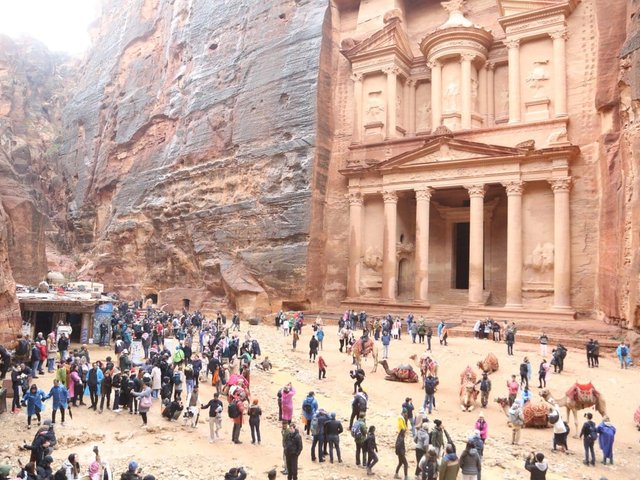Eroded by the elements over the centuries, the ruins of Petra are beginning to suffer the effects of increasing mass tourism. The many monuments hewn two thousand years ago out of the rock are particularly vulnerable. Every year, nearly half a million visitors are expected to fill some twenty newly built hotels located close to the ancient site. Entrepreneurs and the Jordanian Ministry of Tourism view these developments favourably while the Heritage Department, which comes under the Ministry of Tourism, can only look on helplessly.
Concerned about the deterioration of the Petra site, UNESCO has just raised the alarm. A team of seven international experts presented a three-hundred page report in July describing the damaging effects of unrestricted tourism aggravated by climatic factors on this extremely fragile site. They also suggested some specific solutions.
Among the major problems described by the UNESCO experts are the influx of tourists and the pollution caused by the horses used by local villagers who have abandoned agriculture and become economically dependent on tourism. Twenty years or so ago, when only a handful of visitors entered Petra each day, the five hundred Bedouins of the Bdul tribe lived in the city’s caves or in tents among the ruins. They have since been rehoused in modern homes in Oum Sayhoun on the outskirts of Petra, where they make a living almost exclusively from tourism and most of them have exchanged their traditional dress for T-shirts and other US surplus wear. One more symptom, say the UNESCO experts, of the harmful effects of tourism.
The main UNESCO proposals are as follows: to re-establish agriculture outside the archaeological sanctuary, and above all on the terraces overlooking the site, re-using the water pipes and tanks dug out of the rock by the Nabataeans to limit erosion, help prevent sandstorms and make the local population less dependent on tourism. To create new tourist trails other than the traditional route which takes visitors over the site from East to West using the narrow siq both as entrance and exit, introducing a circular trail for example; several itineraries are being planned. And lastly, to stagger visits, open a proper tourist information centre, reinforce the steps carved out of the rock and mark the paths.
It remains to be seen whether the proposals will be implemented, a first draft of the report having been ignored by the Jordanian authorities, as was a similar study carried out by UNESCO fifteen years ago at the request of the World Bank. In Jordan itself, a silent bureaucratic conflict has paralysed the best intentions, as the Heritage Department, which has been up in arms for years over the problems of Petra, finds itself under the authority of the Ministry of Tourism, which seems to want to attract as many visitors as possible.
UNESCO hopes that the pressure of certain sponsors—the United States government is prepared to contribute $7 million to Petra, Switzerland will provide $1 million just to preserve the siq—might halt uncontrolled tourism. In Jordan, public opinion is outraged. Rami G. Khouri, President of the Friends of Archaeology, protested in The Jordan Times of 20 June: “If we see foreign tourists mainly as a source of income, and we see our archaeological treasures mainly as the key that unlocks the money box, then we are probably doomed to go down in history as a people that lacked the political resolve, cultural depth and national self-confidence to withstand the assault of an army of tourists waving their wallets.”
Originally appeared in The Art Newspaper as 'The rose red city wears away'


